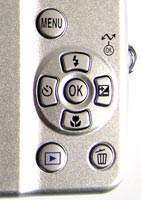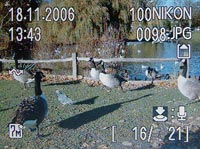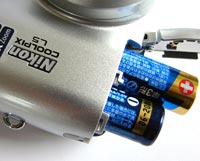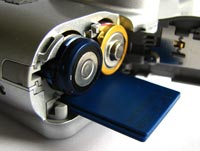Nikon Coolpix L5 Review
Review Date: December 11th 2006
Author: Gavin Stoker
Leave a comment about this Review
|
Ease of Use
Nikon currently has two families of Coolpix pocket compacts; the budget, plastic bodied L (for 'Life') series and the metal bodied, design-led S (for, naturally, 'Style') series. Although rivals might have amalgamated 'Life' and 'Style' into a straightforward 'lifestyle' range, Nikon obviously has its eye on maximizing market-share and seemingly never the twain shall meet. The Nikon Coolpix L5 falls into the first category, and, in a break from numbering tradition, the L5 boasts a higher specification than its sibling, the L6, with 7.2 megapixels and a 5x optical zoom with Vibration Reduction, to the latter's 6 megapixels and standard 3x zoom.
That extra zoom power has meant a slightly larger body for the L5, and a lens housing that stands a centimetre or so proud of the faceplate (by contrast the L6's internally stacked lens is stored flush to the body when not in use). That said, like its little brother the L5 still sits comfortably in both palm and coat pocket. Top right of its lens, if viewed from the front, sits a built-in flash, while above left is a self-timer lamp.
Looking down on the camera, the shutter is situated ergonomically to the left so it falls easily under the forefinger, next to which is the on/off button and, right of this, a built in speaker. The Nikon L5 has dedicated buttons for utilising its Vibration Reduction (a lens-shift mechanism with three settings: normal, active or off), plus the much vaulted Face Priority AF setting that trains focus on a human face, wherever it is in the frame.
Viewed from the back, the L5's LCD screen has a 2.5-inch dimension and un-flashy 115,000-pixel resolution. It doesn't have an optical viewfinder as an alternative means of composing images, but clarity of the LCD is adequate and it's free from ghosting when utilized indoors. The camera features a simple slider control for swapping between fully auto stills capture, selectable scene modes and video capture. This slider is easily accessed thanks to its sensible positioning above the LCD.
| Navigation Pad | LCD Screen |
 |
 |
Top right of the back, the Nikon Coolpix L5 includes a zoom lever that falls readily under the thumb. Directly beneath are the essentials of a menu button and four-way control dial (here called a 'multi selector') for tabbing through and effecting settings via the centrally located 'OK' button. At the points around this dial are a means of adjusting flash settings, plus options for self-timer or distinctly average macro settings. The L5 also includes a dedicated setting for adjusting exposure (+/- 3EV) on the hoof. Below the multi selector are dedicated buttons for playback and deleting unwanted images. The controls are springy to the touch and responsive, and, though there's not much space to play with in terms of layout, it feels uncluttered by options.
The Coolpix L5 is supplied with and powered by two non-rechargeable alkaline AA batteries, which slot into the base of the body and are responsible for a slight curve to one side of the body that acts as a grip. This compartment is shared with a slot for a removable (and optional) SD card, which means you have to cup a hand under the batteries to stop them falling out when swapping cards. You also can't access it when using a tripod (a screw thread for which is provided). It also offers just 8MB of internal memory. Battery life isn't that great, with the L5 offering 150 shots from a single alkaline pair.
A press of the 'menu' button brings up the shooting menu, allowing for a change of image mode, white balance, exposure (+/- 3EV), single, continuous or 16 multi-shot bursts (at 2fps), plus Best Shot Selector (which takes up to 10 images in succession when the shutter button is depressed and held, the sharpest being saved and the others discarded). There's also a range of colour options, including vivid and (like Nikon's new D40 D-SLR) cyanotype, plus a choice of matrix or centre weighted metering and either auto or centre AF area.
There is a wait close to three seconds before you can fire off the first shot from cold, the screen bursting into life while the 5x zoom extends to maximum wide angle setting. The monitor displays the capture mode, the flash setting chosen, a memory card icon and the number of shots remaining, plus the resolution in use, and, occasionally a flashing hand icon to warn of the danger of camera shake in low light.
The Setup menu further includes the option to format the card in use and a brief smattering of less-than-essential offerings, such as having on-screen settings displayed as text or cartoonish icons. You can also select your own image for a welcome screen upon power up. Switching the capture slider to 'scene' setting reveals 15 options, from within which you can also adjust image resolution if required. These include the usual suspects of portrait and landscape (both day and night) plus the likes of fireworks and museum settings.
| Battery Compartment | Memory Card Slot |
 |
 |
If you select night portrait, the Nikon L5 automatically selects the red eye reduction flash setting for you. The video mode boasts maximum 640x480 pixels (displaying 'TV' for TV quality) while allowing adjustment of auto focus from single AF (the camera as usual focuses when the shutter button is pressed halfway) for fairly static subjects to full-time AF (the camera constantly adjusts focuses even when the shutter button isn't pressed) for moving subjects.
Pressing the playback and the menu buttons delivers a brief set of options, including slideshow, the deletion of selected or all images, image protection to prevent accidental loss, plus direct print options, the ability to down-res an image or copy it between card in use and internal memory, or vice versa. If so wished, recorded images can also be cropped in-camera by zooming in using the zoom lever, and auto red-eye fix and Nikon's D-Lighting faculty again features on this compact – the latter via which image brightness is automatically boosted.
As the above would suggest, the L5 is fairly frill-free, making it ideally suited to the beginner who merely wants a pocket camera for straightforward point and shooting. The L5 and it's VR facility will allows you to do a lot of natural light photography without flash. Of course Vibration Reduction's not a failsafe, but at least allows for a greater number of useable shots than might be achievable without. It's also a slight irritation that you can't manually adjust ISO on the L5, but arguably since it's an entry-level model, its target audience won't miss it too much.
The L5 is simple enough for a child or elderly parent to operate. Even though the L5 offers ISO 800 shooting, as mentioned not being able to directly adjust ISO speed when even the most rudimentary models offered by the competition allow this (even if they do peak at ISO 400) was slightly frustrating. Use of this point-and-shoot model is therefore probably best restricted to people snapshots, with either plenty of light available or use of flash acceptable.
|
![]() PhotographyBLOG
is a member of the DIWA
organisation. Our test results for the Nikon Coolpix L5 have
been submitted to DIWA
for comparison with test results for different samples of
the same camera model supplied by other DIWA
member sites.
PhotographyBLOG
is a member of the DIWA
organisation. Our test results for the Nikon Coolpix L5 have
been submitted to DIWA
for comparison with test results for different samples of
the same camera model supplied by other DIWA
member sites.
